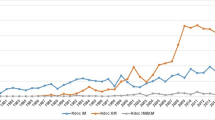Abstract
The purpose of this empirical study is to analyze and map the content of the International Journal of Computer-Supported Collaborative Learning since its inception in 2006. Co-word analysis is the general approach that is used. In this approach, patterns of co-occurrence of pairs of items (words or phrases) identify relationships among ideas. Distances based on co-occurrence frequencies measure the strength of these relationships. Hierarchical clustering and multidimensional scaling are the two complementary exploratory methods relying on these distances that are used to analyze and map the data. Some interesting findings of the work include a map of the key topics covered in the journal and a set of complementary techniques for investigating more specific questions.














Similar content being viewed by others
References
Beale, A. D. (1987). Towards a distributional lexicon. In R. Garside, G. Leech, & G. Sampson (Eds.), The computational analysis of English: A corpus-based approach (pp. 149–162). London: Longman.
Callon, M., Courtial, J.-P., Turner, W. A., & Bauin, S. (1983). From translations to problematic networks: An introduction to co-word analysis. Social Science Information, 22(2), 191–235.
Cress, U., & Kimmerle, J. (2008). A systemic and cognitive view on collaborative knowledge building with wikis. International Journal of Computer-Supported Collaborative Learning, 3(2), 105–122.
Deerwester, S., Dumais, S. T., Furnas, G. W., Landauer, T. K., & Harshman, R. (1990). Indexing by latent semantic analysis. Journal of the American Society for Information Science, 41, 391–407.
Ding, Y., Chowdhury, G., & Foo, S. (2001). Bibliometric cartography of information retrieval research by using co-word analysis. Information Processing and Management, 37(6), 817–842.
Dohn, N. (2009). Web 2.0: Inherent tensions and evident challenges for education. International Journal of Computer-Supported Collaborative Learning, 4(3), 343–363.
Edwards, D. (1995). Graphical Modeling. In W. J. Krzanowski (Ed.), Recent advances in descriptive multivariate analysis (pp. 135–156). Oxford, New York: Clarendon Press.
Fischer, G., Rohde, M., & Wulf, V. (2007). Community-based learning: The core competency of residential, research-based universities. International Journal of Computer-Supported Collaborative Learning, 2(1), 9–40.
Francis, J. G. F. (1961). The QR transformation, I. The Computer Journal, 4(3), 265–271.
Glassman, M., & Kang, M. J. (2011). The logic of wikis: The possibilities of the Web 2.0 classroom. International Journal of Computer-Supported Collaborative Learning, 6(1), 93–112.
Grefenstette, G. (1994). Explorations in automatic thesaurus discovery. Boston: Kluwer Academic Publishers.
Hung, D., Lim, K. Y. T., Chen, D.-T. V., & Koh, T. S. (2008). Leveraging online communities in fostering adaptive schools. International Journal of Computer-Supported Collaborative Learning, 3(4), 373–386.
Jardine, N., & Sibson, R. (1971). Mathematical taxonomy. New York: Wiley.
Kienle, A., & Wessner, M. (2006). An analysis of the CSCL community: Development of participation. International Journal of Computer-Supported Collaborative Learning, 1(1), 9–33.
Kim, S.-S., Kwon, S., & Cook, D. (2000). Interactive visualization of hierarchical clusters using MDS and MST. Metrika, 51(1), 39–51.
Kohonen, T. (1982). Self-organized formation of topologically correct feature maps. Biological Cybernetics, 43, 59–69.
Kruskal, J. B., & Wish, M. (1978). Multidimensional scaling. Sage University Paper series on Quantitative Application in the Social Sciences, 07-011. Beverly Hills: Sage Publications.
Langfelder, P., Zhang, B., & Horvath, S. (2008). Defining clusters from a hierarchical cluster tree: The dynamic tree cut package for R. Bioinformatics, 24(5), 719–720.
Larusson, J. A., & Altermann, R. (2009). Wikis to support the “collaborative” part of collaborative learning. International Journal of Computer-Supported Collaborative Learning, 4(4), 371–402.
Liu, X., Bollen, J., Nelson, M. L., & Van de Sompel, H. (2005). Co-authorship networks in the digital library research community. Information Processing and Management, 41, 1462–1480.
Lund, A., & Rasmussen, I. (2008). The right tool for the wrong task? Match and mismatch between first and second stimulus in double stimulation. International Journal of Computer-Supported Collaborative Learning, 3(4), 387–412.
MacQueen, J. B. (1967). Some Methods for classification and Analysis of Multivariate Observations. In Proceedings of 5th Berkeley Symposium on Mathematical Statistics and Probability (pp. 281–297). Berkeley: University of California Press.
Nett, B. (2008). A community of practice among tutors enabling student participation in a seminar preparation. International Journal of Computer-Supported Collaborative Learning, 3(1), 53–67.
Pifarré, M., & Staarman, J. K. (2011). Wiki-supported collaborative learning in primary education: How a dialogic space is created for thinking together. International Journal of Computer-Supported Collaborative Learning, 6(2), 187–205.
Porter, M. F. (1980). An algorithm for suffix stripping. Program, 14(3), 130–137.
Price, D., & Beaver, D. (1966). Collaboration in an invisible college. American Psychologist, 21, 1011–1018.
Salton, G., & McGill, M. J. (1986). Introduction to modern information retrieval. New York: Mc Graw-Hill, Inc.
Spearman, C. (1950). Human ability. London: Macmillan.
Stahl, G. (2002). Contributions to a theoretical framework for CSCL. In G. Stahl (Ed.), Proceedings International Conference of Computer Supported Collaborative Learning, CSCL’2002 (pp. 62–71).
Steinbach, M., Karypis, G. & Kumar, V. (2000). A comparison of document clustering techniques. University of Minnesota, Technical report #00-034. http://www.cs.fit.edu/~pkc/classes/ml-internet/papers/steinbach00tr.pdf
White, H. D., & Griffith, B. C. (1981). Author cocitation: A literature measure of intellectual structure. Journal of the American Society for Information Science, 32, 163–171.
White, H. D., & McCain, K. W. (1998). Visualizing a discipline: An author co-citation analysis of information science, 1972–1995. Journal of the American Society for Information Science, 49, 327–355.
Zellig, H. (1954). Distributional structure. Word, 10(2/3), 146–162.
Zipf, G. K. (1932). Selected studies of the principle of relative frequency in language. Cambridge: Harvard University Press.
Author information
Authors and Affiliations
Corresponding author
Rights and permissions
About this article
Cite this article
Lonchamp, J. Computational analysis and mapping of ijCSCL content. Computer Supported Learning 7, 475–497 (2012). https://doi.org/10.1007/s11412-012-9154-z
Received:
Accepted:
Published:
Issue Date:
DOI: https://doi.org/10.1007/s11412-012-9154-z




